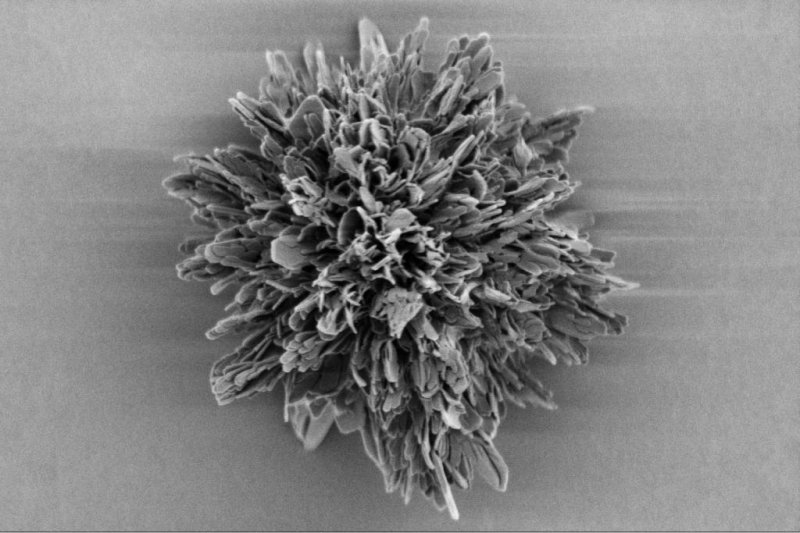The new particle is made up of gold-cysteine nanosheets that all twist in the same direction. Photo by Wenfeng Jiang/Kotov Lab/University of Michigan
April 10 (UPI) -- Scientists have successfully synthesized the most complex microparticle in the world, its structural intricacies more complicated than even the most involved particles found in nature.
The particle is made up of twisted spikes tangled into a gumball-like sphere measuring just a few microns, or millionths of a millimeter, in diameter.
In their paper on the novel microparticle, published this week in the journal Science, researchers claim the new particle could be used to create more stable fluid-particle mixtures, like paints, or to manipulate light for holographic projectors and other kinds of optical technologies.
When designing the new particle, researchers took cues from some nature's most complex spiky particles, including plant pollen, immune cells and some viruses. However, algae particles, spiky coccolithophores, served as the main inspiration for the new synthetic particle.
After studying how spiky coccolithophores choreograph their construction, researchers attempted to replicate the particle's complexities in the lab. But until now, scientists didn't have a uniform method for measuring a microparticle's complexity -- they couldn't be certain they were approximating its complexities correctly.
"Numbers rule the world, and being able to rigorously describe spiky shapes and put a number on complexity enables us to use new tools like artificial intelligence and machine learning in designing nanoparticles," lead researcher Nicholas Kotov, an engineering professor at Michigan, said in a news release.
Kotov and his research partners, including scientists from Brazil, California and Pennsylvania, developed their own framework for measuring the complexity of spiky particles.
An important component of complexity is chirality, the quality of twisting in different but symmetric directions.
Researchers seeded their microparticles with nanoscale gold sulfide sheets. To introduce chirality, scientists coated the sheets in cysteine, an amino acid that comes in two mirror-image forms. The amino acid caused some of the sheets to take on a clockwise twist and others to adopt a counter clockwise twist. Scientists created tiny balls from the twisted gold spines. They found the most complex particles were actually those made from spikes all twisting the same direction.
By using sheets, scientists were able to create flat spikes, which are easier to manipulate and assemble than round spikes. Researchers used charged molecules to assemble the twisted spikes into larger particles.
The complexity of pollen ensures particles don't stick together, allowing the pollen to disperse more efficiently. In lab tests, scientists found their new synthetic microparticle quickly dispersed in almost any liquid. Tests also showed the particles absorb UV light and emit circularly polarized visible light.
Scientists expect the unique mechanical and optical properties of the new particles can help researchers improve upon all kinds of technologies, including biosensors, electronics and the efficiency of chemical reactions.















